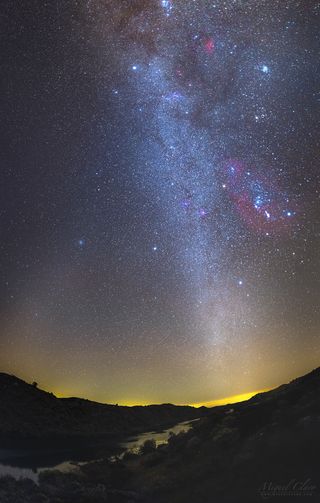Vibrant Nebulas and Zodiacal Light Gleam Over Portuguese Waterfall (Photo)

Miguel Claro is a professional photographer, author and science communicator based in Lisbon, Portugal, who creates spectacular images of the night sky. As a European Southern Observatory Photo Ambassador and member of The World At Night and the official astrophotographer of the Dark Sky Alqueva Reserve, he specializes in astronomical "Skyscapes" that connect both Earth and night sky. Join Miguel here as he takes us through his photograph "Zodiacal Light and Winter Constellations above Pulo do Lobo."
Red-violet nebulas and brilliant star clusters embellish the winter Milky Way in this vertical panorama captured from Pulo do Lobo, a waterfall located in the Dark Sky Alqueva Reserve of southern Portugal.
At the top of the image, just to the right of the Milky Way's dusty glow, we find the California Nebula, a red emission nebula shaped like the state of California. To its right is a bright blue star cluster called the Pleiades, whose seven brightest stars are collectively known as the "Seven Sisters." [Holiday Lights: Forgotten Winter Constellations Now Visible at Night]
Below and near the right center, a reddish emission coming from the constellation Orion the Hunter contains several bright nebulas, like Barnard's Loop, the Horsehead Nebula and the Orion Nebula, surrounding the main brightest stars of the Orion constellation. To the left of Orion, and in the middle of the Milky Way, a violet emission from the Rosette Nebula is also visible.
Closer to the horizon at the left edge of the image, a faint white light seems to shine a spotlight on the Beehive star cluster. Known as Zodiacal Light, this phenomenon is caused by sunlight scattering off of interplanetary dust. Most of this dust is orbiting the sun in about the ecliptic plane.
To capture this image, I used a Nikon D810A DSLR astrophotography camera with a 14-24mm lens set to 14mm with an aperture set to f/2.8, an ISO setting of 2500 and an exposure time of 30 seconds. The final result is a vertical panorama of three photos.
Get the Space.com Newsletter
Breaking space news, the latest updates on rocket launches, skywatching events and more!
Editor's note: If you captured an amazing astronomy photo and would like to share it with Space.com for a story or gallery, send images and comments to managing editor Tariq Malik at spacephotos@space.com.
To see more of Claro's amazing astrophotography, visit his website, www.miguelclaro.com. Follow us @Spacedotcom, Facebook and Google+. Original article on Space.com.
Join our Space Forums to keep talking space on the latest missions, night sky and more! And if you have a news tip, correction or comment, let us know at: community@space.com.
Most Popular

